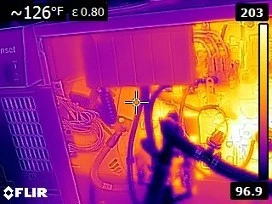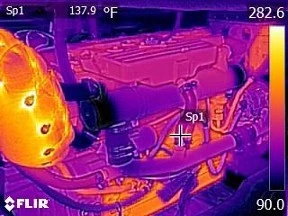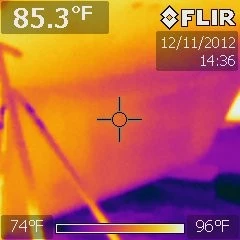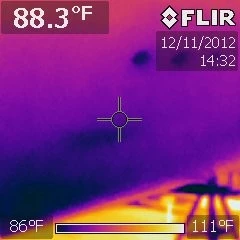Understanding Thermal Imaging
Thermal imaging, also known as infrared imaging, thermography, or thermal scanning, is a technique employed to locate or create images of objects based on the heat they emit. This technology captures the heat radiated by objects and generates visual representations, making it a valuable tool in various fields.
In the images provided, you can see a comparison between a standard thermal image and a Thermal MSX® Image. The latter, utilizing MSX® technology, produces a sharper and cleaner thermal image, enhancing the ease of problem detection.
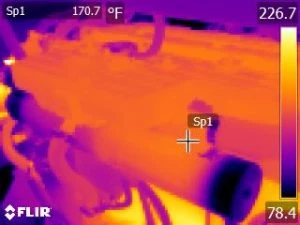
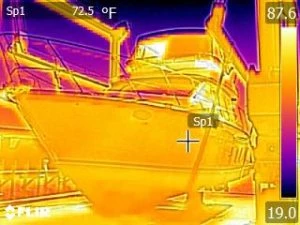
In the context of marine surveying, where non-intrusive assessment is crucial, thermal imaging serves as an invaluable asset. Unlike traditional inspection methods that require disassembly, thermal imaging allows surveyors to peer inside components without physical intervention. This technology grants them the ability to inspect alternators, electrical panels, power steering pumps, and assess bearing conditions, including wear and misalignment. Without thermal imaging, identifying impending issues would be significantly more challenging.
Thermal scans are especially adept at identifying potential problems in engine cooling systems, such as heat exchangers, bearings, manifolds, risers, and other components. They can reveal issues like coolant obstruction, which might remain hidden without the aid of a marine mechanic or electrician. It’s important to note that thermal imaging complements the expertise of professionals, and its integration enhances the efficiency of marine surveyors.
How Thermal Imaging Works
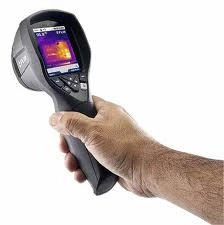 Thermal imaging is a valuable tool for detecting temperature anomalies in machinery and electrical equipment. Since all objects emit some degree of thermal radiation, thermal imaging is effective on a variety of materials, including wood, aluminum, steel, and fiberglass. Moreover, thermal cameras can operate in complete darkness, as they do not rely on visible light. While the technology is well-established in various industries, it’s relatively new in marine surveying.
Thermal imaging is a valuable tool for detecting temperature anomalies in machinery and electrical equipment. Since all objects emit some degree of thermal radiation, thermal imaging is effective on a variety of materials, including wood, aluminum, steel, and fiberglass. Moreover, thermal cameras can operate in complete darkness, as they do not rely on visible light. While the technology is well-established in various industries, it’s relatively new in marine surveying.
At Sun Coast Marine Surveying, we use FLIR® brand infrared cameras, specifically those equipped with MSX® technology. This proprietary technology is unique to FLIR® cameras and enhances thermal images by incorporating details from an onboard visible light camera in real time. The result is a thermal image with labels, numbers, and structural details that make object identification more straightforward.
The process involves capturing three images of the target object:
- Digital Image
- Thermal Image
- Thermal MSX
The Thermal MSX® image combines these three images into a clear, easily recognizable overlay. FLIR® software facilitates the viewing of these images.
Advantages of Thermal Imaging
The advantages of thermal imaging in marine surveying are manifold:
- Non-invasive Survey: Thermal imaging eliminates the need for surveyors to physically touch hot and moving engine components, ensuring their safety. It also allows inspection of electrical components without the risk of electrocution.
- Real-Time Results: Scanning and recording with a thermal camera are instantaneous, saving time and resources during inspections.
- Identifying Temperature Anomalies: Thermal patterns can be readily observed, reducing the need for additional technician or mechanic involvement during a boat inspection, thus saving both time and money.
- Enhanced Survey Reports: At Sun Coast Marine Surveying and Consulting, we offer thermal imaging as a complimentary service. It aids in assessing components such as electrical systems, tanks, gearboxes, engines, hulls, and decks, allowing us to identify faults, leaks, or delamination, which we include in our survey reports.
Enhancing Vessel Safety with Thermography
Thermography plays a pivotal role in ensuring the safety of your vessel. It not only helps identify existing issues but also anticipates potential problems. This information safeguards your investment by preventing electrical fires, detecting leaks, and identifying irregularities in the engine that might lead to costly repairs.
In the provided image, thermal imaging revealed delamination, highlighting its ability to uncover structural issues that might go unnoticed using traditional survey methods.
While we embrace new technologies, we at Sun Coast Marine Surveying and Consulting continue to rely on traditional surveying methods, including percussion soundings and moisture meters. Our use of FLIR® thermal cameras equipped with MSX® imaging technology allows us to offer comprehensive surveys that set us apart from our competition, ensuring that we deliver the best service to our clients.
